Western sandpipers stop at this B.C. mudflat to fuel up during their 10,000-km migration

Western sandpipers are fascinating tiny shorebirds that embark on an incredible journey every spring. These birds, weighing only as much as a slice of bread, migrate from their wintering grounds in Peru to breeding sites in Alaska and Siberia. Along the way, they make crucial stopovers to refuel, one of which is the intertidal mudflats of Roberts Bank near Vancouver.
Roberts Bank serves as a vital last meal for the western sandpipers before they continue their journey north. This mudflat, located next to the GCT Deltaport shipping-container terminal, is a critical site for the birds’ survival. It is estimated that 42 to 64 percent of the global population of western sandpipers rely on Roberts Bank to rest and refuel, with almost all individuals using the site at least once in their lifetime.
A documentary titled “Sandpipers’ Last Supper,” written and directed by Isabelle Groc, captures the awe-inspiring sight of tens of thousands of western sandpipers blanketing Roberts Bank. The film delves into why this location is so important for the birds and highlights the threats it faces.
For years, scientists believed that the western sandpipers fed on small marine invertebrates in the mud at Roberts Bank. However, Bob Elner, a scientist emeritus at Environment and Climate Change Canada, began to question this theory in the 1990s. Through careful observation and research, Elner and his colleagues discovered that the birds were actually consuming an intertidal biofilm that coats the mudflat every spring.
This biofilm, rich in omega-3 fatty acids produced by diatoms, provides the energy boost that the western sandpipers need to complete their arduous journey. The birds’ unique adaptation, a hairy tongue resembling a mop, allows them to extract these essential nutrients from the biofilm. This discovery was groundbreaking, as no other bird species was known to feed on biofilm in this way.
Unfortunately, Roberts Bank is now at risk due to a proposed major port expansion. This development could jeopardize the biofilm that is crucial for millions of migrating shorebirds, including the western sandpipers. If the biofilm is lost, the consequences for the birds could be dire, potentially leading to negative impacts on their populations and pushing the species towards extinction.
The loss of Roberts Bank would not only affect the western sandpipers but also have broader ecological implications, impacting other species such as orcas and chinook salmon. Local communities, like the Tsawwassen First Nation, would also feel the effects of losing this vital habitat.
In the documentary, “Sandpipers’ Last Supper,” viewers are taken on a journey to explore the importance of Roberts Bank and the intertidal biofilm to the survival of western sandpipers. The film sheds light on the urgent need to protect this critical habitat and the delicate balance of ecosystems that depend on it.
To learn more about the western sandpipers’ remarkable migration and the threats facing Roberts Bank, watch “Sandpipers’ Last Supper” on CBC Gem or “The Nature of Things” YouTube channel.




